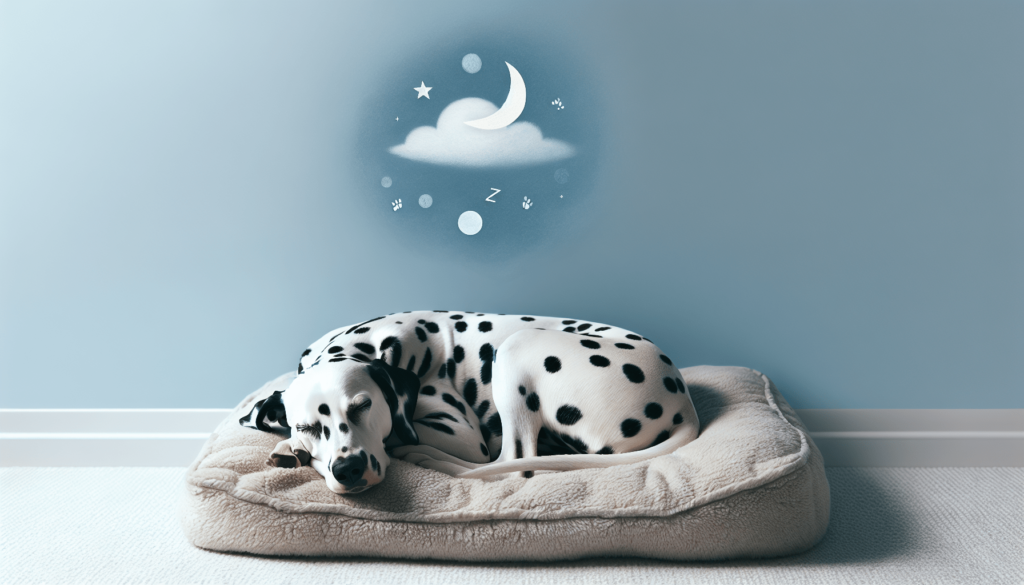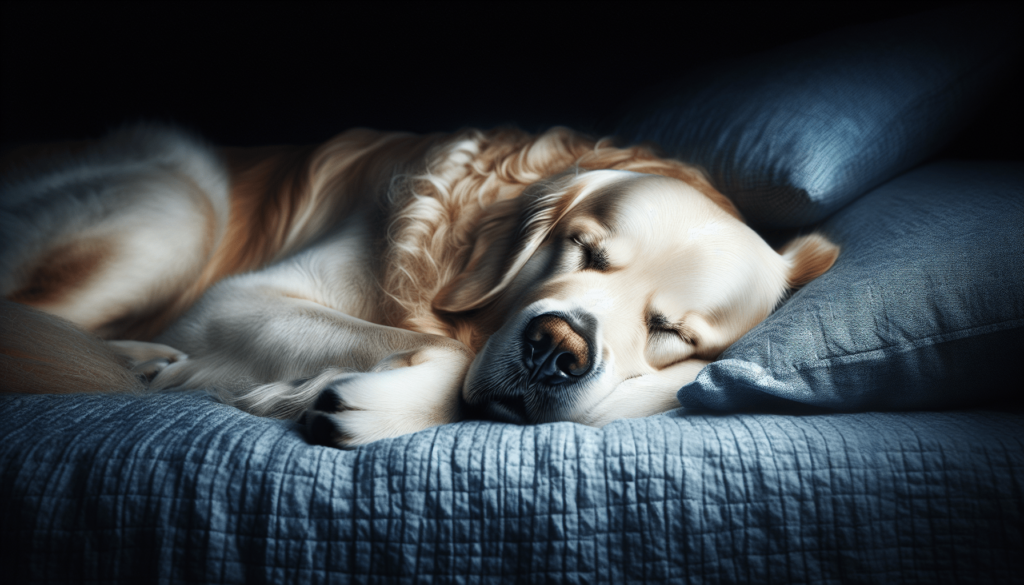Did you know that dogs have sleep patterns just like humans? Understanding the sleep patterns of your canine companion can help you ensure they get the rest they need for optimal health and well-being. From rapid eye movement (REM) sleep to non-REM sleep, dogs experience different sleep phases just like we do. In this article, we will explore the fascinating world of canine sleep patterns and discover what they mean for your furry friend. So, grab a comfy blanket and let’s delve into the realm of doggy dreams!

1. Sleep Duration
Adult Dogs
Adult dogs typically sleep for about 12-14 hours a day. However, the exact sleep duration can vary depending on factors such as breed, size, age, and activity level. Some adult dogs may require slightly more or less sleep, but it is important to ensure that they get enough rest to stay healthy and energized.
Puppies
Puppies, on the other hand, require significantly more sleep than adult dogs. They need about 18-20 hours of sleep per day, as their bodies and brains are still developing. This extensive period of sleep is crucial for their growth, as it allows their bodies to recharge and their brains to process and retain new information.
Senior Dogs
As dogs age, their sleep patterns may change. Senior dogs tend to sleep more throughout the day and may also experience more interruptions during the night. This is often due to various factors such as age-related health conditions, discomfort, or a decrease in bladder control. Providing a comfortable and quiet sleeping environment can help senior dogs sleep more peacefully.
2. Sleep Positions
On the Side
One common sleep position for dogs is lying on their side. This position allows dogs to fully stretch out their bodies while they sleep. It is a comfortable position and is often observed in dogs that feel secure and relaxed in their surroundings.
On the Back
You may occasionally find your dog sleeping on their back with their belly exposed. This position indicates a deep level of trust and comfort, as dogs typically only sleep on their back when they feel safe and secure in their environment.
Curled Up
Many dogs enjoy sleeping curled up into a ball, often referred to as the “fetal position.” This position allows dogs to conserve body heat and protect their vital organs. It is commonly seen in dogs that feel cozy and seek comfort.
Stretched Out
Some dogs prefer to sprawl out when they sleep, with their legs extended in different directions. This position is often observed in dogs that feel more relaxed and secure, as they are exposing their vulnerable belly without feeling any need to protect themselves.
3. REM Sleep
Definition
REM (Rapid Eye Movement) sleep is a stage of sleep characterized by rapid eye movements, increased brain activity, and vivid dreaming. In dogs, REM sleep is similar to that experienced by humans. During this stage, the brain is highly active and engaged in processing emotions, learning, and memory consolidation.
Duration
Dogs spend a significant amount of their sleep time in REM sleep. On average, about 10-12% of a dog’s sleep is spent in REM sleep. Puppies and senior dogs may spend even more time in REM sleep, as their brains are actively developing or going through changes.
Importance
REM sleep is crucial for dogs as it helps regulate their emotions, strengthen memory, and aid in learning new tasks. It is during this stage that dogs may twitch, wag their tails, or make noises as they react to their dreams. REM sleep is essential for their overall mental and emotional well-being.
4. Non-REM Sleep
Definition
Non-REM sleep is the stage of sleep when the body and brain are not as active as during REM sleep. It is a deeper and more restful sleep stage, during which the body repairs and regenerates tissues.
Stages
Non-REM sleep consists of several stages, including light sleep and slow-wave sleep (also known as deep sleep). During light sleep, dogs may still be easily awakened, while deep sleep is a more restorative phase where the body experiences reduced brain activity and relaxation.
Functions
Non-REM sleep plays a vital role in allowing the body to recover from daily activities and restore energy. It promotes physical growth, repairs tissues, strengthens the immune system, and enhances overall physical well-being. Dogs that do not get enough deep sleep may feel sluggish and have difficulty focusing during the day.

5. Sleep Cycles
Length and Frequency
A dog’s sleep cycle typically lasts around 90 minutes. Within this cycle, dogs go through multiple stages of both REM and non-REM sleep. Adult dogs may complete 4-5 sleep cycles in a 24-hour period, while puppies and senior dogs may have more frequent sleep cycles.
Transition between Stages
The transition between sleep stages is fluid, and dogs may move between light sleep, deep sleep, and REM sleep throughout the night. Just like humans, dogs may show signs of sleep disturbances or even wake up briefly during these transitions. These interruptions are usually normal and not a cause for concern unless they become excessive or affecting their overall well-being.
6. Sleep Patterns by Breed
Breeds with High Sleep Needs
Some breeds have naturally higher sleep needs due to factors such as size, energy levels, and genetic predisposition. Large breeds like Great Danes and Saint Bernards tend to require more sleep than smaller breeds. Similarly, working breeds such as Border Collies and Siberian Huskies, which are highly active during the day, may need extra rest to replenish their energy levels.
Breeds with Low Sleep Needs
On the other hand, certain small breeds, like Chihuahuas and Jack Russell Terriers, tend to have lower sleep needs. These breeds are often more alert and may be content with shorter naps throughout the day. It is important to remember that individual dogs within a breed may still vary in their sleep requirements, so it is essential to observe and cater to your dog’s specific needs.
7. Environmental Factors
Temperature
Maintaining a suitable sleeping temperature is crucial for your dog’s comfort and quality of sleep. Most dogs prefer a cool sleeping environment, ideally between 65-75°F (18-24°C). Avoid exposing your dog to extreme temperatures, as it can disrupt their sleep and affect their overall well-being.
Lighting
Providing a dark and quiet sleeping environment is important for dogs to get quality rest. Dogs have sharper senses than humans, and excessive light or noise can disturb their sleep. Consider using blackout curtains or creating a cozy sleeping area away from bright lights and loud noises.
Noise
While some dogs may be able to sleep through various noises, others may be more sensitive to sound. If your dog is easily disturbed by external noises such as thunderstorms or traffic, consider using white noise machines or calming music to drown out disruptive sounds and create a more peaceful environment.
Comfort
Ensuring that your dog’s sleeping area is comfortable is essential for their well-being. Provide a clean and soft bed or blanket, and consider the size and shape of the bed to accommodate their sleeping preferences. Regularly washing bedding will also help keep your dog’s sleeping area clean and free of allergens.
8. Sleep Disorders
Insomnia
Just like humans, dogs can experience insomnia, a condition characterized by difficulty falling asleep or staying asleep. Insomnia in dogs can be caused by various factors, including discomfort, anxiety, environmental disruptions, or an underlying medical condition. If you suspect your dog is experiencing insomnia, it is best to consult with a veterinarian to address the underlying cause.
Sleep Apnea
Sleep apnea is a sleep disorder characterized by pauses in breathing during sleep. While less common in dogs than in humans, certain breeds may be more prone to this condition due to their anatomy. Symptoms of sleep apnea in dogs include snoring, gasping for air during sleep, and excessive daytime sleepiness. If you suspect sleep apnea in your dog, seek veterinary guidance for diagnosis and potential treatment options.
Narcolepsy
Narcolepsy is a neurological disorder that causes sudden and uncontrollable episodes of sleep during wakeful hours. While rare in dogs, certain breeds, such as Dachshunds and Labrador Retrievers, may be more susceptible to this condition. Symptoms of narcolepsy in dogs include sudden collapse, weakness in the legs, and excessive sleepiness. Consulting a veterinarian is crucial for managing and treating narcolepsy in dogs.
Restless Leg Syndrome
Restless Leg Syndrome (RLS) is a condition characterized by an irresistible urge to move the legs, usually during periods of rest or sleep. While rare in dogs, RLS can cause discomfort and disrupt sleep patterns. Signs of RLS in dogs include restless leg movements, scratching or licking at the legs, and difficulty settling down to sleep. It is important to consult with a veterinarian to determine the cause of these symptoms and explore treatment options if necessary.
9. Human-Canine Sleep Comparison
Similarities
Humans and dogs share some similarities in sleep patterns. Both species experience REM and non-REM sleep stages, and their brains undergo similar processes of memory consolidation and emotional processing during sleep. Dogs, like humans, also have sleep cycles and go through transitions between sleep stages.
Differences
There are notable differences between human and canine sleep patterns as well. Dogs require more sleep than humans, particularly in their early stages of life and as they age. Additionally, the structure and duration of each sleep stage may vary between humans and dogs. Dogs tend to have shorter REM cycles and more time in non-REM sleep compared to humans.
Co-Sleeping
Many dog owners choose to co-sleep with their pets, allowing their dogs to share their beds at night. Co-sleeping can foster a sense of comfort and security for both the dog and the owner. However, it is important to ensure that both the owner and the dog are comfortable, and co-sleeping does not disrupt sleep for either party. If co-sleeping becomes an issue, providing a separate comfortable sleeping area for the dog is recommended.
10. Taking Care of Your Dog’s Sleep
Creating a Comfortable Sleeping Environment
To optimize your dog’s sleep, provide a clean and comfortable sleeping area tailored to their preferences. Consider factors such as temperature, lighting, noise, and the overall comfort of their bed or blanket. This will help ensure that your dog can rest peacefully and wake up refreshed.
Establishing a Bedtime Routine
Just like humans, dogs benefit from a regular bedtime routine. Establish a consistent schedule for feeding, exercise, and bedtime, as this will help regulate their internal clock and signal when it’s time to wind down and sleep. Engaging in calming activities before bed, such as gentle play or a calming massage, can also promote relaxation and prepare your dog for sleep.
Ensuring Regular Exercise
Providing regular exercise for your dog is vital for their overall well-being and sleep quality. Physical activity helps release pent-up energy and ensures that your dog stays physically tired. A tired dog is more likely to sleep soundly and experience a deeper, more restorative sleep. However, it is important to avoid exercising your dog too close to bedtime, as this can overstimulate them and make it harder for them to settle down to sleep.
By understanding and addressing your dog’s sleep patterns and needs, you can help promote their overall health and well-being. By creating a comfortable sleeping environment, establishing a bedtime routine, and ensuring regular exercise, you can help your furry friend enjoy restful and rejuvenating sleep, allowing them to be their best selves every day.

